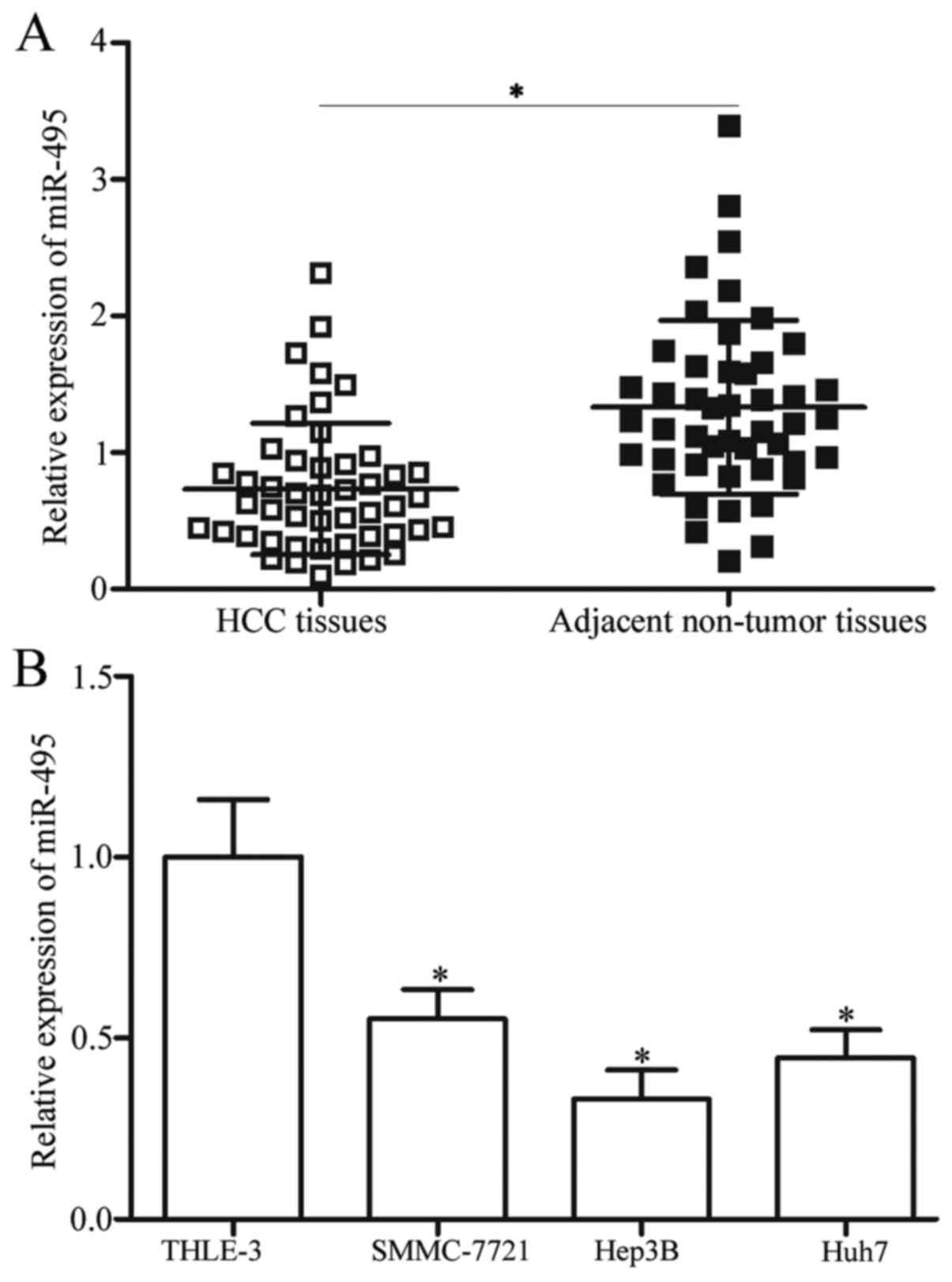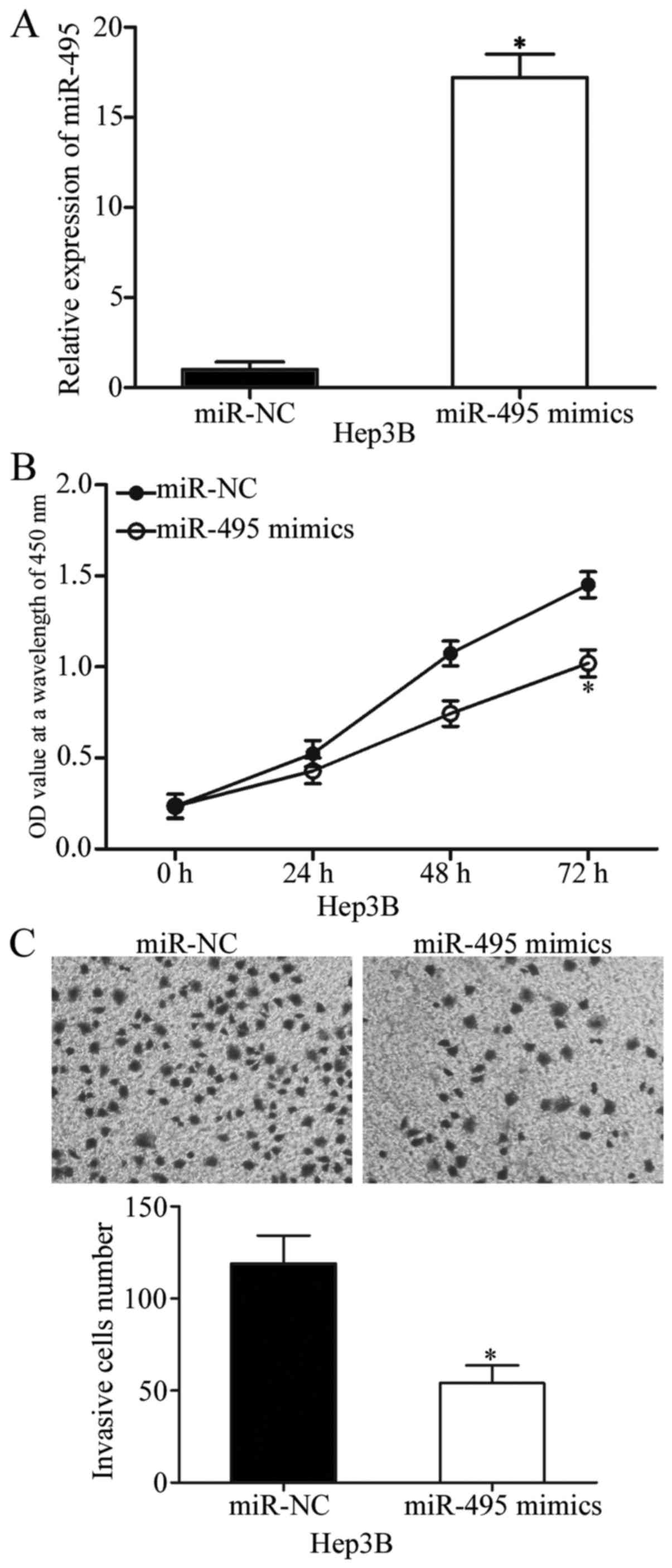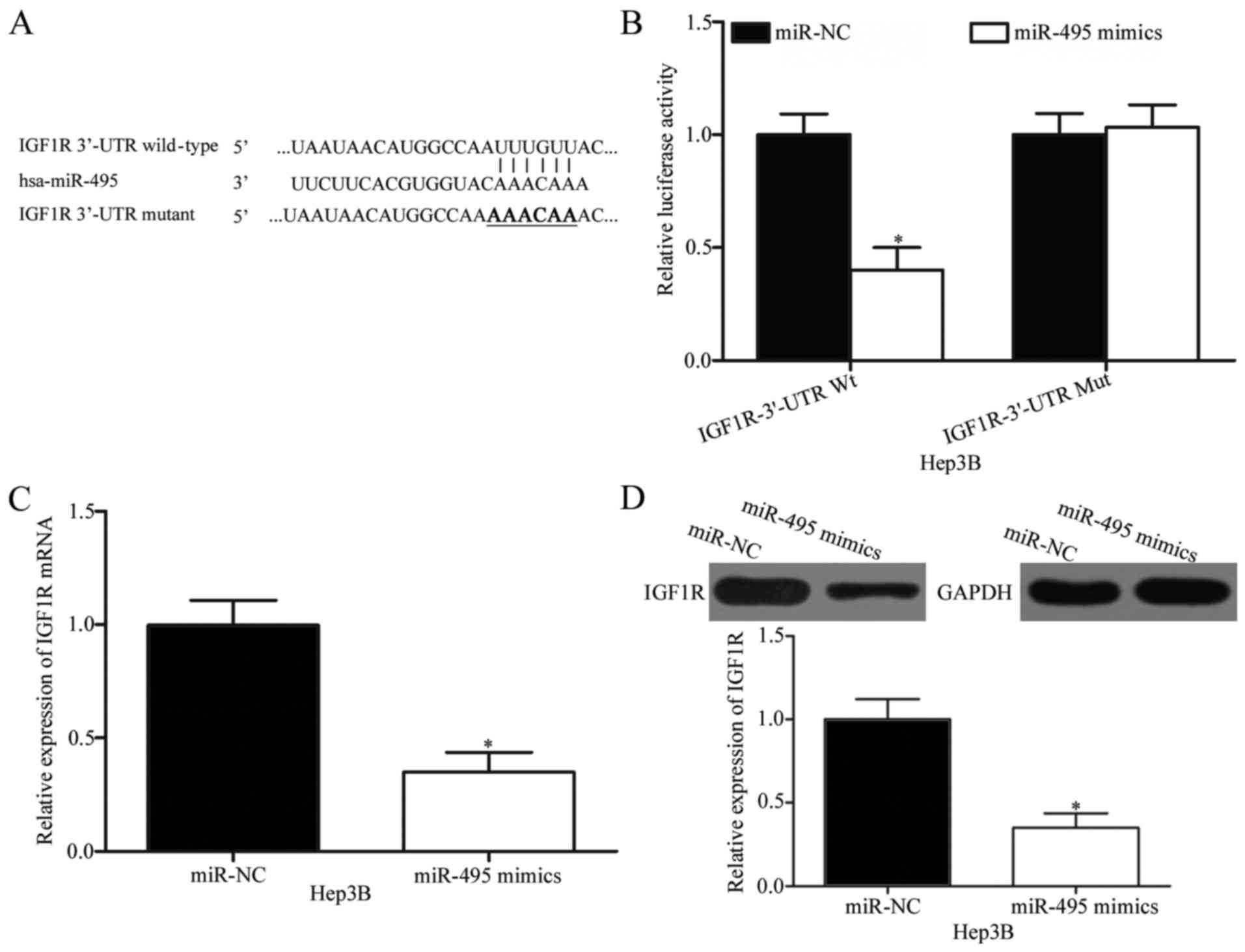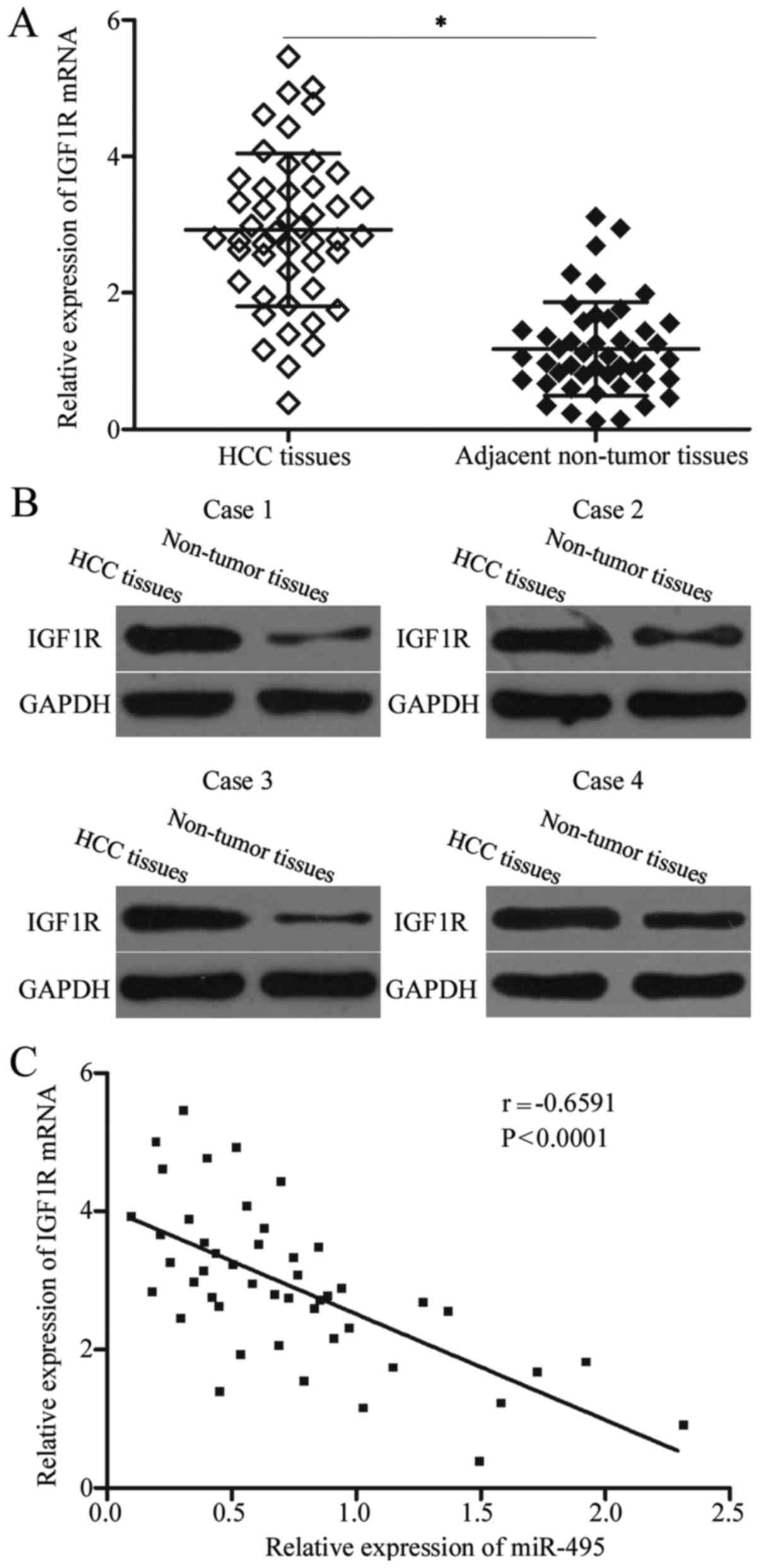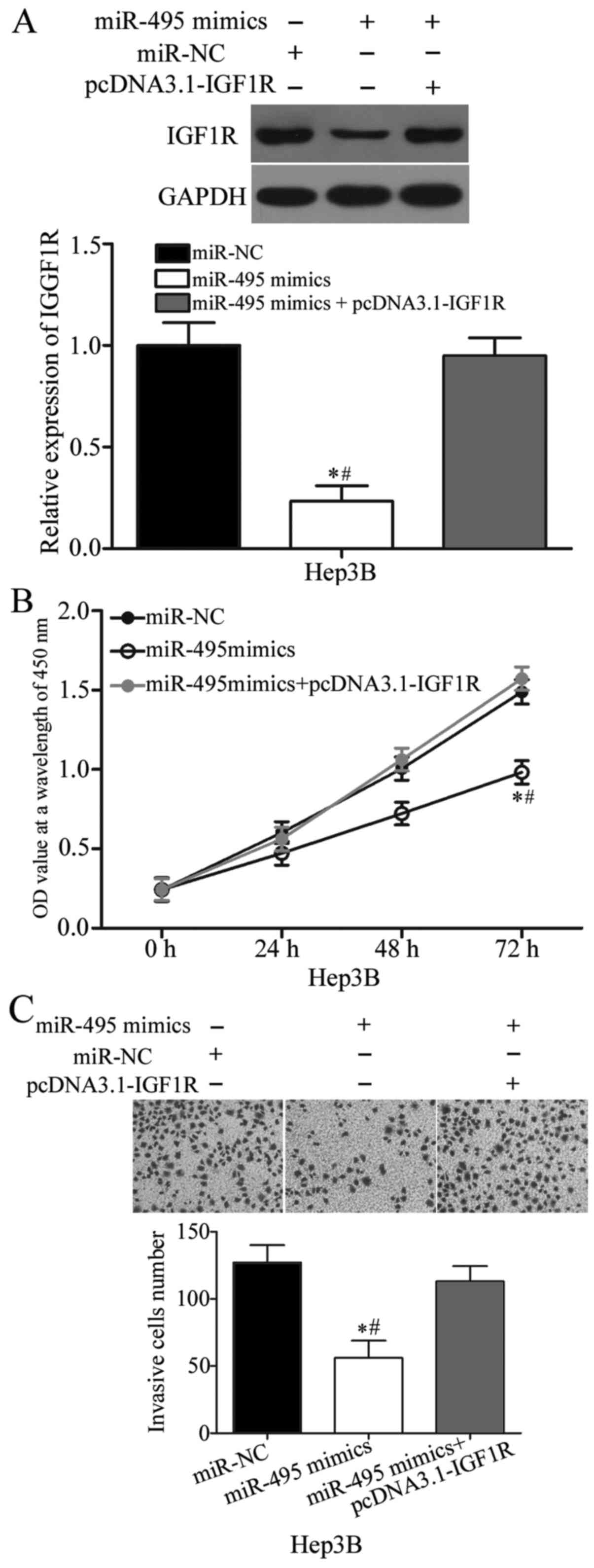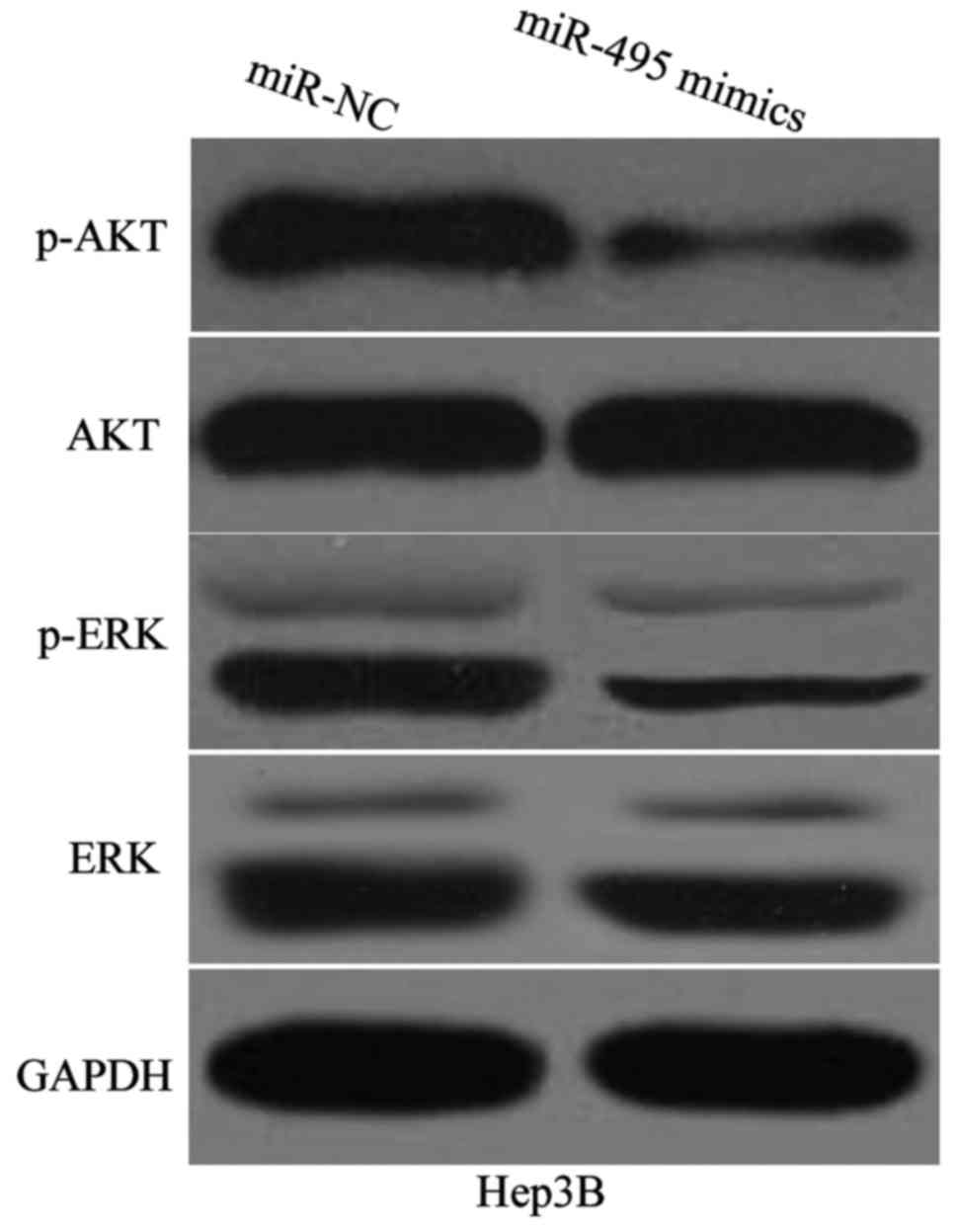MicroRNA‑495 suppresses cell proliferation and invasion of hepatocellular carcinoma by directly targeting insulin‑like growth factor receptor‑1
Retraction in: /10.3892/etm.2022.11432
- Authors:
- Published online on: November 8, 2017 https://doi.org/10.3892/etm.2017.5467
- Pages: 1150-1158
Abstract
Introduction
Hepatocellular carcinoma (HCC), the fifth-most common malignancy and second-most frequent cause of cancer-related deaths worldwide (1,2), accounts for approximately 780,000 new cases and 745,000 deaths attributed to HCC each year (3). Multiple risk factors, including hepatitis B virus or hepatitis C virus infection, dietary aflatoxin B1 contamination, chronic alcohol abuse and tobacco consumption, lack of dietary antioxidants, arsenic exposure, obesity and non-alcoholic fatty liver disease, involved in HCC formation and progression have been identified (2,4). Chronic infection with hepatitis B virus or hepatitis C virus causes approximately 75% of all HCC cases (5). Although advanced treatments for patients with HCC have been developed, the long-term prognosis for these patients remains poor, and their current 5-year survival rate is approximately 30% (6). In addition, molecular mechanisms underlying HCC development have yet to be fully elucidated (7). Therefore, the molecular mechanisms of HCC initiation and progression should be further investigated to establish novel prognostic biomarkers and therapeutic methods for patients with this disease.
MicroRNAs (miRNAs/miRs), an endogenous group of short (18–25 nucleotides), non-coding and single-stranded RNA molecules, have emerged as a major regulator of tumourigenesis and tumour development (8,9). miRNAs negatively regulate gene expression by typically binding to complementary sequences in 3′-untranslated regions (3′-UTRs) of their target genes and therefore stimulate mRNA degradation or translational inhibition (10). Altered miRNA expression has been described in various types of human malignancies, such as HCC (11), renal cell carcinoma (12), gastric cancer (13) and colorectal cancer (14). miRNA dysregulation has been demonstrated to be involved in various cellular biological processes, including cell proliferation, cell cycle, apoptosis, angiogenesis, invasion, migration, epithelial-to-mesenchymal transition and metastasis (15–17). In human cancer, miRNAs may serve as tumour suppressors or oncogenes which mainly depend on the biological roles of their target genes (13). Highly expressed miRNAs act as oncogenes by inhibiting tumour suppressor gene function, whereas downregulated miRNAs function as tumour suppressor genes through oncogene downregulation (14,15). Therefore, the expression and molecular mechanisms of miRNAs in human cancers should be further investigated to propose therapeutic targets for anticancer treatments.
miR-495, mapped in the 14q32.31 region, is abnormally expressed in multiple types of human cancers, such as upregulated in bladder cancer (18), and downregulated in osteosarcoma (19), melanoma (20), endometrial cancer (21), acute myeloid leukaemia (22). However, the expression level and roles of miR-495 in HCC have yet to be completely elucidated. In our study, the expression levels of miR-495 in HCC tissues and cell lines were examined, and the effects of this miRNA on cell proliferation and invasion were evaluated in vitro. The underlying mechanism of miR-495 in HCC cells was also determined. Our study might provide novel insights into HCC occurrence and development.
Materials and methods
Human tissue specimens
A total of 47 individual primary HCC tissues and matched adjacent non-tumor tissues were collected from patients who underwent surgical resection at the Seventh People's Hospital of Shanghai University of Traditional Chinese Medicine (Shanghai, China) between May 2014 and January 2016. None of these HCC patients had been treated with chemotherapy or radiotherapy before surgery. All tissues specimens were flash-frozen in liquid nitrogen immediately after collection and stored at −80°C. This study was approved by the Ethics Committee of the Seventh People's Hospital of Shanghai University of Traditional Chinese Medicine, and written informed consent was also obtained from all participants prior to their participation in the study.
Cell lines and culture conditions
Three human HCC cell lines (SMMC-7721, Hep3B, and Huh7) and immortalized normal liver epithelial cell line (THLE-3) were purchased from the Cell Bank of Type Culture Collection of Chinese Academy of Sciences (Shanghai, China).
All HCC cell lines were cultured in Dulbecco's modified Eagle's medium (DMEM) supplemented with 10% fetal bovine serum (FBS; bth from Gibco, Grand Island, NY, USA), 100 U/ml penicillin and 100 µg/ml streptomycin (Sigma-Aldrich, Merck KGaA, Darmstadt, Germany). THLE-3 cell line was maintained in Bronchial Epithelial Cell Growth Medium (Clonetics Corporation, Walkersville, MD, USA) containing 10% FBS, 5 ng/ml EGF and 70 ng/ml Phosphoethanolamine (both from Sigma-Aldrich, Merck KGaA). All cell lines were grown at 37°C in humidified atmosphere with 5% CO2.
Oligonucleotide transfection
Mature miR-495 mimics and miRNA mimics negative control (miR-NC) were chemically synthesized by GeneCopoeia (Shanghai, China). Insulin-like growth factor receptor-1 (IGF1R) overexpression plasmid (pcDNA3.1-IGF1R) and empty plasmid (pcDNA3.1) were acquired from Shanghai GenePharma Co., Ltd. (Shanghai, China). For cell transfection, cells were seeded into 6-well plates at a density of 5×105 cells per well. After incuabtion overnight, cell transfection was performed using Lipofectamine 2000 (Invitrogen Life Technologies, Carlsbad, CA, USA), according to the manufacturer's instructions.
Reverse transcription-quantitative polymerase chain reaction (RT-qPCR)
Total RNA was isolated from tissue specimens or cells using TRIzol reagent (Invitrogen; Thermo Fisher Scientific, Inc., Waltham, MA, USA) in accordance with the manufacturer's instructions. For miR-495 quantification, complementary DNA (cDNA) was synthesized from 1 µg of total RNA using the TaqMan microRNA Reverse Transcription kit (Applied Biosystems, Foster City, CA, USA). Quantification of miR-495 was performed using a TaqMan microRNA Assay kit (Applied Biosystems; Thermo Fisher Scientific, Inc.). U6 small nuclear RNA was used as an endogenous control. To quantify IGF1R mRNA, corresponding cDNA was obtained form total RNA with a PrimeScript RT Reagent kit (Takara Biotechnology, Co., Ltd., Dalian, China), according to the manufacturer's protocols. The quantitative PCR was carried out in an Applied Biosystems® 7500 Real-Time PCR system (Applied Biosystems; Thermo Fisher Scientific, Inc.) using SYBR Premix Ex Taq™ kit (Takara Biotechnology, Co., Ltd.), with GAPDH as an internal control. All reactions were performed in triplicate and fold changes were calculated based on relative quantification using the 2−ΔΔCq method (23).
Cell Counting kit-8 (CCK-8) assay
CCK-8 assay was utilized to determine the HCC cell proliferative ability. Transfected cells were collected at 24 h post-transfection, and mechanically dissociated into single cell suspension. Afterwards, transfected cells were seeded into 96-well plates at a density of 3,000 cells/well, and incubated at 37°C with 5% CO2 for 0, 24, 48, and 72 h. At each time point, CCK-8 assay was performed according to the manufacturer's protocols. Briefly, each well was treated with 10 ul CCK-8 reagent (Dojindo Molecular Technologies, Inc., Kumamoto, Japan). After incubating at 37°C for additional 2 h, the optical density (OD) at a wavelength of 450 nm was determined using a Spectramax M5 microplate reader (Molecular Devices LLC, Sunnyvale, CA, USA). Each assay was performed with 5 replications.
Cell invasion assay
Cell invasion assay was performed using Transwell insert chambers (8-µm pore size; Corning, Inc., Corning, NY, USA) coated with Matrigel (BD Biosciences, San Jose, CA, USA). After transfection 48 h, cells were harvested and suspended in FBS-free DMEM. Transfected cells (5×104) in 300 µl FBS-free DMEM were seeded into the upper chamber. The lower chambers were then filled with DMEM containing 10% FBS. Following a 24 h incubation at 37°C with 5% CO2, non-invaded cells were removed using a cotton swab. Invasive cells were fixed with 4% polyoxymethylene, stained with 0.5% crystal violet, washed with PBS and dried in air. Finally, invasive cells were counted in five randomly selected visual fields under an inverted microscope (magnification, ×200; Olympus Corporation, Tokyo, Japan).
Target prediction
The TargetScan (http://www.targetscan.org/) and PicTar (http://pictar.mdc-berlin.de/) were used to predict the potential targets of miR-495.
Luciferase reporter assay
Bioinformatic analysis indicated a potential miR-495 binding site in the 3′-UTR region of IGF1R. Lciferase reporter plasmids, pMIR-IGF1R-3′-UTR wild-type (Wt) and pMIR-IGF1R-3′-UTR wild mutant (Mut), were chemically synthesized by Shanghai GenePharma Co., Ltd. Cells were seeded into 24-well plates at a density of 1.5×105 cells per well. After incubaiton overnight, cells were co-transfected with the wild-type or mutant 3′-UTR of IGF1R plasmid, and miR-495 mimics or miR-NC using the Lipofectamine 2000 reagent, according to the manufacturer's protocol. After transfection 48 h, the relative luciferase activity was detected using the Dual-Luciferase Reporter assay system (Promega Corporation, Madison, WI, USA), according to the manufacturer's instructions. Renilla luciferase activity served as an internal control. Each assay was performed in 3 replicates and repeated at least three times.
Western blot analysis
Total protein was isolated from tissue specimens or cells with Radioimmunoprecipitation assay lysis buffer (Beyotime Institute of Biotechnology, Haimen, China) containing 0.1 mg/ml phenylmethylsulfonyl fluoride, 1 mM sodium orthovanadate and 1 mg/ml aprotinin. The concentration of total protein was quantified with BCA assay kit (Beyotime Institute of Biotechnology). Equal amount of protein was separated by 10% SDS-PAGE and electronically transferred onto a polyvinylidene difluoride membrane (EMD Millipore, Billerica MA, USA). After blocking with 5% nonfat milk in TBST for 2 h at room temperature, the membranes were incubated with primary antibodies at 4°C overnight. The primary antibodies used in this study include mouse anti-human monoclonal IGF1R antibody (sc-81464; 1:1,000 dilution), mouse anti-human monoclonal p-AKT (sc-271966; 1:1,000 dilution), mouse anti-human monoclonal AKT (sc-81434; 1:1,000 dilution), mouse anti-human monoclonal p-ERK (sc-81492; 1:1,000 dilution), mouse anti-human monoclonal ERK (sc-514302; 1:1,000 dilution), and mouse anti-human monoclonal GAPDH antibody (sc-47724; 1:1,000 dilution; all from Santa Cruz Biotechnology, Santa Cruz, CA, USA). Subsequent washing three times with TBST, the membranes were probed with goat anti-mouse horseradish peroxidase (HRP)-conjugated secondary antibody (sc-2005; 1:5,000 dilution; Santa Cruz Biotechnology) at room temperature for 2 h. Protein bands were visualized using an enhanced chemiluminescence kit (EMD Millipore), and analyzed using ImageJ 1.49 (National Institutes of Health, Bethesda, MD, USA). GAPDH served as a loading control.
Statistical analysis
Data are shown as the mean ± standard error of at least three independent experiments, and analyzed with Student's t-test or one-way analysis of variance. SPSS 17.0 software (SPSS, Inc., Chicago, IL, USA) was used to perform statistical analysis. Spearman's correlation analysis was adopted to investigate the association between miR-495 and IGF1R mRNA expression level in HCC tissues. P<0.05 was considered statistically significant.
Results
miR-495 is downregulated in HCC tissues and cell lines
To determine the potential roles of miR-495 in HCC, RT-qPCR was performed to detect miR-495 expression levels in 47 primary HCC tissues and matched adjacent non-tumour tissues. Our results demonstrated that miR-495 was significantly downregulated in HCC tissues compared with that in matched adjacent non-tumour tissues (P<0.05; Fig. 1A). The miR-495 expression was also examined in three HCC cell lines, namely, SMMC-7721, Hep3B and Huh7, and in immortalized normal liver epithelial cell line, namely, THLE-3. In Fig. 1B, the miR-495 expression levels in the four HCC cell lines were lower than that of THLE-3 (P<0.05). Among these HCC cell lines, Hep3B yielded the lowest miR-495 expression levels and thus were selected for further functional studies. These results suggested that miR-495 may be involved in the formation and progression of HCC.
Low miR-495 expression is correlated with adverse clinical features of patients with HCC
The patients with HCC were subsequently divided into either miR-495 low-expression group (n=24) or miR-495 high-expression group (n=23) to elucidate the clinical significance of miR-495 in HCC. The median expression levels of miR-495 in HCC tissues were regarded as cut-off. As shown in Table I, the low miR-495 expression level was correlated with tumour size (P=0.028), tumor-node-metastasis (TNM) stage (P=0.013) and lymph node metastasis (P=0.011). Conversely, miR-495 expression was not correlated with other clinical features, including age (P=0.642), sex (P=0.471), HBsAg (P=0.413), and differentiated (P=0.471). These results implied that miR-495 may be a prognostic indicator for patients with HCC.
Table I.Association between miR-495 expression and clinical features of hepatocellular carcinoma patients. |
miR-495 inhibits cell proliferation and invasion in HCC
Hep3B cells were transfected with miR-495 mimics or miR-NC to examine the effects of miR-495 on the biological characteristics of tumours. Transfection efficiency was determined through RT-qPCR, and the results indicated that miR-495 was markedly upregulated in Hep3B cells transfected with miR-495 mimics (P<0.05; Fig. 2A). CCK-8 assay was conducted to verify the effect of miR-495 overexpression on HCC cell proliferation. In Fig. 2B, upregulation of miR-495 inhibited Hep3B cell proliferation (P<0.05). Cell invasion assay was also performed to show the effect of miR-495 on HCC cell invasion abilities. The results demonstrated that the restored miR-495 expression reduced the invasive capabilities of Hep3B cells (P<0.05; Fig. 2C). These results illustrated the tumour-suppressive effects of miR-495 on HCC cell proliferation and invasion.
IGF1R is a direct downstream target of miR-495 in HCC
To investigate the mechanisms by which miR-495 plays its tumour-suppressing roles in HCC, bioinformatics analysis was conducted to predict the candidate targets of miR-495. IGF1R, which is highly expressed in HCC and possibly involved in HCC formation and progression (24,25), was predicted as a potential target of miR-495 (Fig. 3A) and consequently selected for further experimental validation. To confirm this hypothesis, we carried out a luciferase reporter assay in Hep3B cells co-transfected with wild-type or mutant 3′-UTR of IGF1R plasmid and miR-495 mimics or miR-NC. In Fig. 3B, ectopic miR-495 expression significantly decreased the luciferase activity of pMIR-IGF1R-3′-UTR Wt in Hep3B cells (P<0.05) but did not affect the luciferase activity of pMIR-IGF1R-3′-UTR Mut. To confirm whether IGF1R is a direct target of miR-495, we performed RT-qPCR and Western blot analysis and then determined the regulatory effects of miR-495 on endogenous IGF1R expression in HCC cells. RT-qPCR and Western blot analysis revealed that the restored miR-495 expression suppressed the IGF1R expression in Hep3B cells at mRNA (P<0.05; Fig. 3C) and protein (P<0.05; Fig. 3C) levels. These results suggested that IGF1R is a direct target of miR-495 in HCC.
IGF1R is upregulated in HCC tissues and negatively correlated with miR-495 expression levels
The IGF1R level was examined in HCC tissues and matched adjacent non-tumour tissues to analyse the correlation between miR-495 and IGF1R. In Fig. 4A and B, the IGF1R expression levels were significantly higher in HCC tissues than in matched adjacent non-tumour tissues at mRNA (P<0.05) and protein (P<0.05) levels. Spearman's correlation analysis revealed that miR-495 was negatively associated with the mRNA expression level of IGF1R in HCC tissues (r=−0.6591, P<0.001; Fig. 4C).
IGF1R upregulation rescues the tumour-suppressive roles induced by miR-495 overexpression in HCC
Rescue experiments were performed to confirm whether the biological roles of miR-495 in HCC are mediated by IGF1R. Hep3B cells were transfected with miR-495 mimics with or without IGF1R overexpression plasmid (pcDNA3.1-IGF1R). Western blot analysis indicated that miR-495 overexpression decreased the IGF1R protein expression, whereas pcDNA3.1-IGF1R co-transfection could rescue the IGF1R expression in Hep3B cells (P<0.05; Fig. 5A). Subsequent functional assays demonstrated that the restored IGF1R expression rescued the suppressive effects of miR-495 on the proliferation (P<0.05; Fig. 5B) and invasion of Hep3B cells. These results implied that miR-495 plays its tumour-suppressing roles in HCC partly by downregulating IGF1R.
miR-495 attenuates AKT and ERK signalling pathways in HCC
IGF1R likely performs its functions partly by participating in the regulation of AKT and ERK signalling pathways (26–28). To determine whether miR-495 is involved in the regulation of AKT and ERK pathways in HCC, we detected the expression levels of AKT, p-AKT, ERK and p-ERK in Hep3B cells transfected with miR-495 mimics or miR-NC. Western blot analysis demonstrated that miR-495 overexpression reduced the expression of p-AKT and p-ERK in Hep3B cells (Fig. 6). Conversely, the expression of total AKT and ERK in these two cell lines did not significantly change. These results suggested that miR-495 inactivates AKT and ERK signalling pathways in HCC.
Discussion
Recently, increasing studies reported that miRNAs are abnormally expressed in various types of human cancers (29–31) and can participate in the tumourigenesis and tumour development of HCC (32,33). miRNA-based targeted therapy is effective against different molecular targets and can increase the sensitisation of cancer cells to therapy by several folds (34). Therefore, further validation of potentially important miRNAs involved in HCC initiation and progression may provide valuable insights into the treatment of patients with HCC. In our study, miR-495 was significantly downregulated in HCC tissues and cell lines. Low miR-495 expression levels were correlated with adverse clinical features of the patients with HCC. The restored expression of miR-495 inhibited the proliferation and invasion of HCC cells in vitro. IGF1R was identified as a direct target of miR-495 in HCC, and miR-495 upregulation attenuated the activation of AKT and ERK signalling pathways in HCC. Therefore, miR-495 might serve as a tumour suppressor in HCC by directly targeting IGF1R and regulating AKT and ERK signalling pathways and might be developed as a novel therapeutic target for the treatment of patients with this fatal malignancy.
miR-495 is aberrantly expressed in numerous types of human cancer. For example, miR-495 is upregulated in bladder cancer tissues and cell lines. High miR-495 expression levels are correlated with tumour size, TNM stage and lymph node metastasis of patients with bladder cancer (18). However, miR-495 in medulloblastoma is downregulated in tumour tissues compared with that in normal cerebellum tissues. Log-rank analysis demonstrated that the average survival time of patients with medulloblastoma and with low miR-495 levels is shorter than that of patients with high miR-495 expression levels. Multivariate analysis also demonstrates miR-495 as an independent predictor of the overall survival of patients with medulloblastoma (35). miR-495 is weakly expressed in prostate cancer and associated with prostate-specific antigen levels, lymph node invasion and Gleason scores (36). miR-495 is also downregulated in osteosarcoma (19), melanoma (20), endometrial cancer (21), acute myeloid leukaemia (22), renal cell carcinoma (37), breast cancer (38,39) and lung cancer (40,41). These findings suggested that miR-495 expression exhibits tissue specificity and may be a biomarker for these human cancers.
miR-495 plays tumour-suppressive roles in multiple types of human malignancy. For instance, Jiang et al revealed that miR-495 overexpression suppresses osteosarcoma cell proliferation, colony formation, invasion and increased apoptosis in vitro (19). Studies showed that miR-495 upregulation inhibits cell proliferation and invasion and induces a metabolic shift in glioma (42–44). Formosa et al (36) and Li et al (45) indicated that the restored miR-495 expression attenuates prostate cancer cell growth and metastasis and promotes apoptosis in vitro. Liu et al reported that ectopic miR-495 expression decreases cell proliferation and metastasis and triggers cell apoptosis of melanoma (20). Xu et al demonstrated that miR-495 re-expression represses endometrial cancer cell growth and migration, promotes apoptosis and reduces growth in vivo (21). Lv et al found that restored miR-495 expression inhibits cell proliferation and motility and induces G0/G1 phase arrest in renal cell carcinoma (37). In lung cancer, miR-495 is involved in the regulation of cell proliferation, migration, epithelial-mesenchymal transition, chemosensitivity and chemoresistance (40,41,46). However, Tan et al indicated that miR-495 serves as an oncogene in bladder cancer through the regulation of cell proliferation and invasion (18). These conflicting findings suggested that the functional roles of miR-495 in human malignancies may be multifaceted and mainly dependent on involved tissues and their target genes.
The following target miR-495 genes have been identified: HMGN5 (19) in osteosarcoma; GFI1 (35) in medulloblastoma; Glut1 (42), MYB (43) and CDK6 (44) in glioma; FZD4 (36), Akt (45) and mTOR (45) in prostate cancer; SATB1 (37) in renal cell carcinoma; STAT-3 (38) and Bmi-1 (39) in breast cancer; epithelial and endothelial tyrosine kinase (40), MTA3 (41) and ATP7A (46) in lung cancer; and PTEN (18) in bladder cancer. In our study, IGF1R was demonstrated to be a direct functional downstream target of miR-495 in HCC. IGF1R, a transmembrane tyrosine kinase receptor of the insulin receptor family, has been reported to be upregulated in multiple types of cancer, such as osteosarcoma (47), colorectal cancer (48), prostate cancer (49), gastric cancer (50), endometrial cancer (51) and bladder cancer (52). A previous study revealed that IGF1R is significantly upregulated in HCC and correlated with TNM stage. Univariate analysis indicated that high IGF1R expression predicted poor overall and disease-free survival for patients with HCC. In multivariate analysis, IGF1R is significant in the overall survival of patients with HCC (24). Functional experiments demonstrated that IGF1R downregulation inhibits HCC cell proliferation and invasion but increases apoptosis (25). Therefore, IGF1R could be developed as a novel therapeutic target in HCC because of its cancer-related functions.
In conclusion, this study is the first to demonstrate that miR-495 inhibited the proliferation and invasion of HCC cells by directly targeting IGF1R and regulating AKT and ERK signalling pathways. These results provide novel insights into the molecular mechanism underlying HCC progression and suggest that miR-495 may be investigated as a novel therapeutic target for patients with HCC.
Acknowledgements
The study was supported by grants from Key Disciplines Group Construction Project of Pudong Health Burea of Shanghai (PWZxq2014-12), Natural Science Foundation of China (no. 81571718), Shanghai Science and Technology Committee Foundation (no. 17ZR1421600), Science and Technology Development Fund of Shanghai Pudong New Area (PKJ2016-Y50) and Talents Training Program of Seventh People's Hospital of Shanghai University of Traditional Chinese Medicine (grant no. QMX2017-01).
References
|
Torre LA, Bray F, Siegel RL, Ferlay J, Lortet-Tieulent J and Jemal A: Global cancer statistics, 2012. CA Cancer J Clin. 65:87–108. 2015. View Article : Google Scholar : PubMed/NCBI | |
|
El-Serag HB and Rudolph KL: Hepatocellular carcinoma: Epidemiology and molecular carcinogenesis. Gastroenterology. 132:2557–2576. 2007. View Article : Google Scholar : PubMed/NCBI | |
|
Forner A, Llovet JM and Bruix J: Hepatocellular carcinoma. Lancet. 379:1245–1255. 2012. View Article : Google Scholar : PubMed/NCBI | |
|
Yu MC and Yuan JM: Environmental factors and risk for hepatocellular carcinoma. Gastroenterology. 127 5 Suppl 1:S72–S78. 2004. View Article : Google Scholar : PubMed/NCBI | |
|
Zeng Z: Human genes involved in hepatitis B virus infection. World J Gastroenterol. 20:7696–7706. 2014. View Article : Google Scholar : PubMed/NCBI | |
|
Dhanasekaran R, Limaye A and Cabrera R: Hepatocellular carcinoma: Current trends in worldwide epidemiology, risk factors, diagnosis, and therapeutics. Hepat Med. 4:19–37. 2012.PubMed/NCBI | |
|
Aravalli RN, Steer CJ and Cressman EN: Molecular mechanisms of hepatocellular carcinoma. Hepatology. 48:2047–2063. 2008. View Article : Google Scholar : PubMed/NCBI | |
|
Kloosterman WP and Plasterk RH: The diverse functions of microRNAs in animal development and disease. Dev Cell. 11:441–450. 2006. View Article : Google Scholar : PubMed/NCBI | |
|
Bartel DP: MicroRNAs: Genomics, biogenesis, mechanism, and function. Cell. 116:281–297. 2004. View Article : Google Scholar : PubMed/NCBI | |
|
Gu S, Jin L, Zhang F, Sarnow P and Kay MA: Biological basis for restriction of microRNA targets to the 3′ untranslated region in mammalian mRNAs. Nat Struct Mol Biol. 16:144–150. 2009. View Article : Google Scholar : PubMed/NCBI | |
|
Yan JJ, Chang Y, Zhang YN, Lin JS, He XX and Huang HJ: miR-195 inhibits cell proliferation via targeting AEG-1 in hepatocellular carcinoma. Oncol Lett. 13:3118–3126. 2017.PubMed/NCBI | |
|
Pengcheng S, Ziqi W, Luyao Y, Xiangwei Z, Liang L, Yuwei L, Lechen L and Wanhai X: MicroRNA-497 suppresses renal cell carcinoma by targeting VEGFR-2 in ACHN cells. Biosci Rep. 37:pii: BSR201702702017. View Article : Google Scholar | |
|
Li F, Guo Y, Liu J and Zhang R: The significance of elevated plasma expression of microRNA 106b~25 clusters in gastric cancer. PLoS One. 12:e01784272017. View Article : Google Scholar : PubMed/NCBI | |
|
Fateh A, Feizi MAH, Safaralizadeh R and Azarbarzin S: Importance of miR-299-5p in colorectal cancer. Ann Gastroenterol. 30:322–326. 2017.PubMed/NCBI | |
|
Lujambio A and Lowe SW: The microcosmos of cancer. Nature. 482:347–355. 2012. View Article : Google Scholar : PubMed/NCBI | |
|
Ebert MS and Sharp PA: Roles for microRNAs in conferring robustness to biological processes. Cell. 149:515–524. 2012. View Article : Google Scholar : PubMed/NCBI | |
|
Iorio MV and Croce CM: microRNA involvement in human cancer. Carcinogenesis. 33:1126–1133. 2012. View Article : Google Scholar : PubMed/NCBI | |
|
Tan M, Mu X, Liu Z, Tao L, Wang J, Ge J and Qiu J: microRNA-495 promotes bladder cancer cell growth and invasion by targeting phosphatase and tensin homolog. Biochem Biophys Res Commun. 483:867–873. 2017. View Article : Google Scholar : PubMed/NCBI | |
|
Jiang W, Zheng J, Yu T and Wang J: Overexpression of microRNA-495 suppresses the proliferation and invasion and induces the apoptosis of osteosarcoma cells by targeting high-mobility group nucleosome-binding domain 5. Oncol Rep. 38:1099–1107. 2017.PubMed/NCBI | |
|
Liu P, Hu Y, Ma L, Du M, Xia L and Hu Z: miR-425 inhibits melanoma metastasis through repression of PI3K-Akt pathway by targeting IGF-1. Biomed Pharmacother. 75:51–57. 2015. View Article : Google Scholar : PubMed/NCBI | |
|
Xu YY, Tian J, Hao Q and Yin LR: MicroRNA-495 downregulates FOXC1 expression to suppress cell growth and migration in endometrial cancer. Tumour Biol. 37:239–251. 2016. View Article : Google Scholar : PubMed/NCBI | |
|
Jiang X, Huang H, Li Z, He C, Li Y, Chen P, Gurbuxani S, Arnovitz S, Hong GM, Price C, et al: MiR-495 is a tumor-suppressor microRNA down-regulated in MLL-rearranged leukemia. Proc Natl Acad Sci USA. 109:pp. 19397–19402. 2012; View Article : Google Scholar : PubMed/NCBI | |
|
Livak KJ and Schmittgen TD: Analysis of relative gene expression data using real-time quantitative PCR and the 2(-Delta Delta C(T)) method. Methods. 25:402–408. 2001. View Article : Google Scholar : PubMed/NCBI | |
|
Lin SB, Zhou L, Liang ZY, Zhou WX and Jin Y: Expression of GRK2 and IGF1R in hepatocellular carcinoma: Clinicopathological and prognostic significance. J Clin Pathol. 70:754–759. 2017. View Article : Google Scholar : PubMed/NCBI | |
|
Yao WF, Liu JW, Sheng GL and Huang DS: Blockade of IGF-IR exerts anticancer effects in hepatocellular carcinoma. Mol Med Rep. 4:719–722. 2011.PubMed/NCBI | |
|
Zhang W, Liu K, Liu S, Ji B, Wang Y and Liu Y: MicroRNA-133a functions as a tumor suppressor by targeting IGF-1R in hepatocellular carcinoma. Tumour Biol. 36:9779–9788. 2015. View Article : Google Scholar : PubMed/NCBI | |
|
Guo T, Feng Y, Liu Q, Yang X, Jiang T, Chen Y and Zhang Q: MicroRNA-320a suppresses in GBM patients and modulates glioma cell functions by targeting IGF-1R. Tumour Biol. 35:11269–11275. 2014. View Article : Google Scholar : PubMed/NCBI | |
|
Chen G, Fang T, Huang Z, Qi Y, Du S, Di T, Lei Z, Zhang X and Yan W: MicroRNA-133a inhibits osteosarcoma cells proliferation and invasion via targeting IGF-1R. Cell Physiol Biochem. 38:598–608. 2016. View Article : Google Scholar : PubMed/NCBI | |
|
Yuan J, Ji H, Xiao F, Lin Z, Zhao X, Wang Z, Zhao J and Lu J: MicroRNA-340 inhibits the proliferation and invasion of hepatocellular carcinoma cells by targeting JAK1. Biochem Biophys Res Commun. 483:578–584. 2017. View Article : Google Scholar : PubMed/NCBI | |
|
Duan X, Bai J, Wei J, Li Z, Liu X and Xu G: MicroRNA-508-5p suppresses metastasis in human gastric cancer by targeting S-phase kinase-associated protein 2. Mol Med Rep. 16:2163–2171. 2017.PubMed/NCBI | |
|
Ma F, Li W, Liu C, Li W, Yu H, Lei B, Ren Y, Li Z, Pang D and Qian C: MiR-23a promotes TGF-beta1-induced EMT and tumor metastasis in breast cancer cells by directly targeting CDH1 and activating Wnt/beta-catenin signaling. Oncotarget. 8:69538–69550. 2017.PubMed/NCBI | |
|
Han K, Li J, Zhao H, Liang P, Huang X, Zheng L, Li Y, Yang T and Wang L: Identification of the typical miRNAs and target genes in hepatocellular carcinoma. Mol Med Rep. 10:229–235. 2014. View Article : Google Scholar : PubMed/NCBI | |
|
Afonso MB, Rodrigues PM, Simão AL and Castro RE: Circulating microRNAs as potential biomarkers in non-alcoholic fatty liver disease and hepatocellular carcinoma. J Clin Med. 5:pii: E302016. View Article : Google Scholar | |
|
Gandhi NS, Tekade RK and Chougule MB: Nanocarrier mediated delivery of siRNA/miRNA in combination with chemotherapeutic agents for cancer therapy: Current progress and advances. J Control Release. 194:238–256. 2014. View Article : Google Scholar : PubMed/NCBI | |
|
Wang C, Yun Z, Zhao T, Liu X and Ma X: MiR-495 is a predictive biomarker that downregulates GFI1 expression in medulloblastoma. Cell Physiol Biochem. 36:1430–1439. 2015. View Article : Google Scholar : PubMed/NCBI | |
|
Formosa A, Markert EK, Lena AM, Italiano D, Finazzi-Agro' E, Levine AJ, Bernardini S, Garabadgiu AV, Melino G and Candi E: MicroRNAs, miR-154, miR-299-5p, miR-376a, miR-376c, miR-377, miR-381, miR-487b, miR-485-3p, miR-495 and miR-654-3p, mapped to the 14q32.31 locus, regulate proliferation, apoptosis, migration and invasion in metastatic prostate cancer cells. Oncogene. 33:5173–5182. 2014. View Article : Google Scholar : PubMed/NCBI | |
|
Lv C, Bai Z, Liu Z, Luo P and Zhang J: MicroRNA-495 suppresses human renal cell carcinoma malignancy by targeting SATB1. Am J Transl Res. 7:1992–1999. 2015.PubMed/NCBI | |
|
Chen Y, Luo D, Tian W, Li Z and Zhang X: Demethylation of miR-495 inhibits cell proliferation, migration and promotes apoptosis by targeting STAT-3 in breast cancer. Oncol Rep. 37:3581–3589. 2017. View Article : Google Scholar : PubMed/NCBI | |
|
Wang L, Liu JL, Yu L, Liu XX, Wu HM, Lei FY, Wu S and Wang X: Downregulated miR-495 [Corrected] inhibits the G1-S phase transition by targeting Bmi-1 in breast cancer. Medicine. 94:e7182015. View Article : Google Scholar : PubMed/NCBI | |
|
Wei T, Zhu W, Fang S, Zeng X, Huang J, Yang J, Zhang J and Guo L: miR-495 promotes the chemoresistance of SCLC through the epithelial-mesenchymal transition via Etk/BMX. Am J Cancer Res. 7:628–646. 2017.PubMed/NCBI | |
|
Chu H, Chen X, Wang H, Du Y, Wang Y, Zang W, Li P, Li J, Chang J, Zhao G and Zhang G: MiR-495 regulates proliferation and migration in NSCLC by targeting MTA3. Tumour Biol. 35:3487–3494. 2014. View Article : Google Scholar : PubMed/NCBI | |
|
Nie S, Li K, Huang Y, Hu Q, Gao X and Jie S: miR-495 mediates metabolic shift in glioma cells via targeting Glut1. J Craniofac Surg. 26:e155–e158. 2015. View Article : Google Scholar : PubMed/NCBI | |
|
Zhang B, Yuan F, Liu J, Li Y, Zhou F, Liu X, Hao Z, Li Q, Zheng Y and Wang W: Hsa-miR-495 acts as a tumor suppressor gene in glioma via the negative regulation of MYB. Mol Med Rep. 14:977–982. 2016. View Article : Google Scholar : PubMed/NCBI | |
|
Chen SM, Chen HC, Chen SJ, Huang CY, Chen PY, Wu TW, Feng LY, Tsai HC, Lui TN, Hsueh C and Wei KC: MicroRNA-495 inhibits proliferation of glioblastoma multiforme cells by downregulating cyclin-dependent kinase 6. World J Surg Oncol. 11:872013. View Article : Google Scholar : PubMed/NCBI | |
|
Li JZ, Wang ZL, Xu WH, Li Q, Gao L and Wang ZM: MicroRNA-495 regulates migration and invasion in prostate cancer cells via targeting Akt and mTOR signaling. Cancer Invest. 34:181–188. 2016. View Article : Google Scholar : PubMed/NCBI | |
|
Song L, Li Y, Li W, Wu S and Li Z: miR-495 enhances the sensitivity of non-small cell lung cancer cells to platinum by modulation of copper-transporting P-type adenosine triphosphatase A (ATP7A). J Cell Biochem. 115:1234–1242. 2014. View Article : Google Scholar : PubMed/NCBI | |
|
Wang YH, Han XD, Qiu Y, Xiong J, Yu Y, Wang B, Zhu ZZ, Qian BP, Chen YX, Wang SF, et al: Increased expression of insulin-like growth factor-1 receptor is correlated with tumor metastasis and prognosis in patients with osteosarcoma. J Surg Oncol. 105:235–243. 2012. View Article : Google Scholar : PubMed/NCBI | |
|
Shiratsuchi I, Akagi Y, Kawahara A, Kinugasa T, Romeo K, Yoshida T, Ryu Y, Gotanda Y, Kage M and Shirouzu K: Expression of IGF-1 and IGF-1R and their relation to clinicopathological factors in colorectal cancer. Anticancer Res. 31:2541–2545. 2011.PubMed/NCBI | |
|
Ma Y, Cheng Q, Ren Z, Xu L, Zhao Y, Sun J, Hu S and Xiao W: Induction of IGF-1R expression by EGR-1 facilitates the growth of prostate cancer cells. Cancer Lett. 317:150–156. 2012. View Article : Google Scholar : PubMed/NCBI | |
|
Gryko M, Kiśluk J, Cepowicz D, Zińczuk J, Kamocki Z, Guzińska-Ustymowicz K, Pryczynicz A, Czyżewska J, Kemona A and Kędra B: Expression of insulin-like growth factor receptor type 1 correlate with lymphatic metastases in human gastric cancer. Pol J Pathol. 65:135–140. 2014. View Article : Google Scholar : PubMed/NCBI | |
|
Pengchong H and Tao H: Expression of IGF-1R, VEGF-C and D2-40 and their correlation with lymph node metastasis in endometrial adenocarcinoma. Eur J Gynaecol Oncol. 32:660–664. 2011.PubMed/NCBI | |
|
Xie QX, Lin XC, Zhang MF, Han CX and Guo YH: Expression of IGF-I and IGF-IR in bladder cancer. Ai Zheng. 23:707–709. 2004.(In Chinese). PubMed/NCBI |



